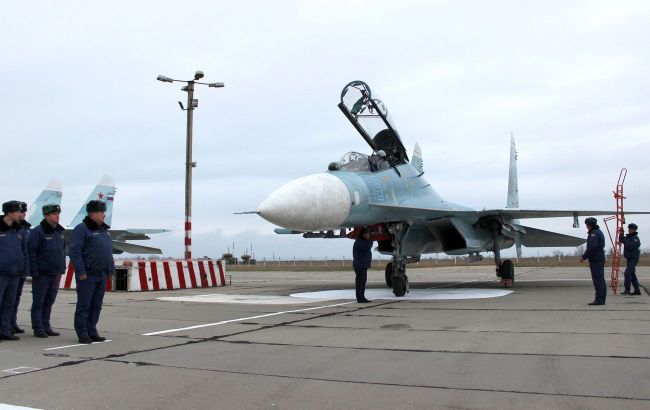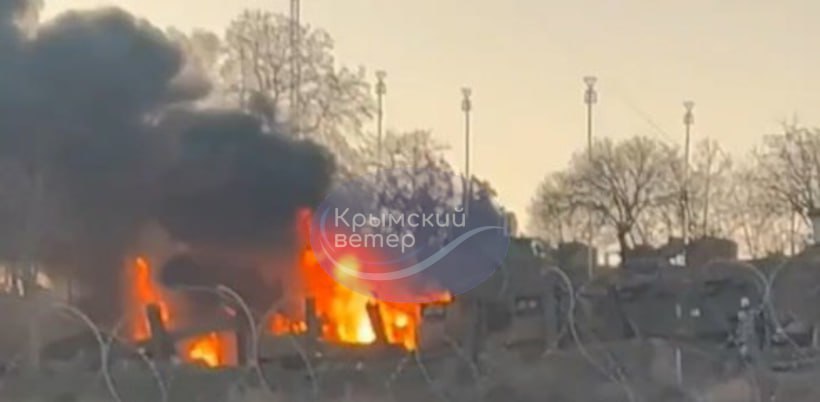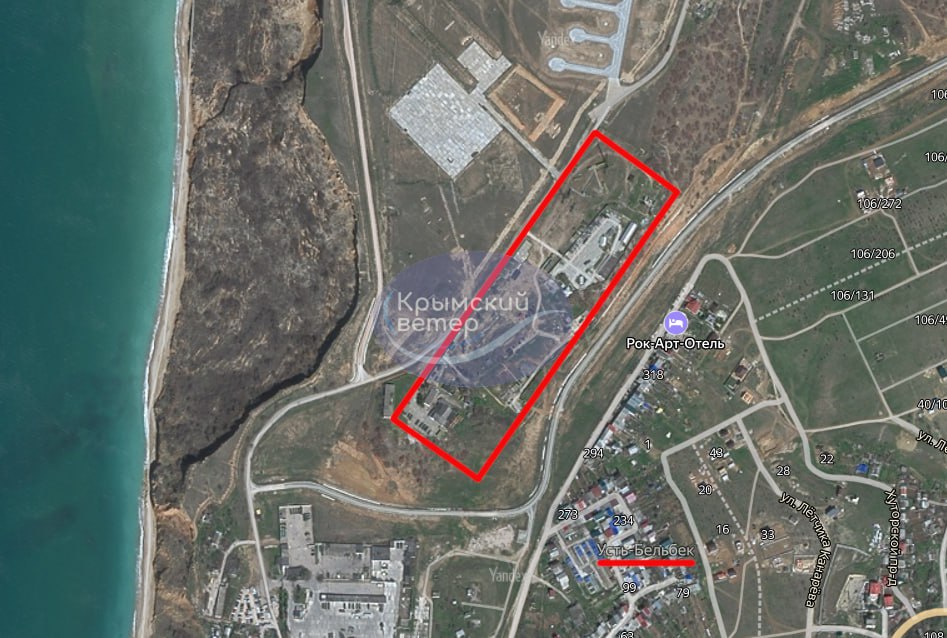Belbek airbase targeted: What's known about Ukraine's attack and potential consequences for Russia in Crimea
 Aerodrome Belbek in occupied Sevastopol (Photo: Getty Images)
Aerodrome Belbek in occupied Sevastopol (Photo: Getty Images)
On the eve, rockets attacked the Belbek airfield in the occupied Crimea. Corresponding videos and photos have appeared online, and the Ukrainian side confirmed the strike but has not yet disclosed specific targets.
For more details on what happened at the enemy airbase, what could have been targeted, and the potential consequences, check out RBC-Ukraine's material.
In preparing the material, data from the Telegram channel Crimean Wind, statements from governor of Sevastopol Mikhail Razvozhaev, the Ministry of Defense of the Russian Federation, Commander of the Air Forces of the Armed Forces of Ukraine Mykola Oleshchuk, military spokespersons Yurii Ihnat and Natalia Humeniuk, Wikipedia, and comments from expert Oleksandr Musiienko were used.
Explosions and fires: What happened at the Balbek airfield
A series of explosions rocked Crimea in the second half of the day on January 31. Initially, around 15:50, loud noises were heard in the vicinity of Sevastopol, Saky, Hvardiiske, and Feodosia. Occupiers declared an air alarm, air defense systems were activated, and aviation took off. Within an hour, subsequent explosions occurred in Sevastopol, Saky district, and footage with smoke over the settlement of Hvardiiske appeared online. Later, reports again surfaced of explosions in the northern part of Sevastopol and Shcholkine on the Kerch Peninsula.
At the same time, news emerged of a fire in the vicinity of the Belbek airfield. The Telegram channel Crimean Wind published a video showing a missile likely hitting one of the objects.
Today, photos of burning Russian equipment after the strike have surfaced.

Photo: Russian burning equipment at the Belbek airfield (t.me/Crimeanwind)
The so-called governor Mikhail Razvozhaev reported the repelling of a massive attack on Sevastopol. According to preliminary data, allegedly six missiles were shot down. Debris fell in the private sector in the area of Fedorivska Street, damaging 12 buildings in the Ust-Belbek gardening community.
The monitoring group of Crimean Wind noted that these cottages are located 250-350 meters from the likely explosion site in the radar station town at the Belbek airfield.
 Photo: Presumably, missiles struck the radar station town (t.me/Crimeanwind)
Photo: Presumably, missiles struck the radar station town (t.me/Crimeanwind)
Despite clear evidence of hits, the Russian Ministry of Defense reported a 100% success rate in dealing with aerial targets. The report claimed that the Ukrainian side allegedly launched 20 guided aviation missiles. Air defense systems shot down 17 of them over the Black Sea and three more over the peninsula itself. The department also stated that "there is no damage to aviation equipment."
In the evening, the Commander of the Air Forces of Ukraine, Mykola Oleshchuk, hinted that Ukrainian aviation could be behind the strike.
"Did you know that the Air Forces of the Armed Forces of Ukraine include the 204th Sevastopol Tactical Aviation Brigade? So, its permanent deployment is at the Belbek airfield! Ukrainian aviators will definitely return home to their native airfield. And now, thanks to everyone who contributed to clearing Crimea of Russian presence," he wrote on his Telegram.
This morning, the spokesperson for the Defense Forces of the South of Ukraine, Natalia Humeniuk, commented on the explosions.
"In fact, the occupiers themselves have already admitted that five missiles found refuge on the territory of temporarily occupied Crimea. They even marked the places where it happened. And admitted that they did not have time to disperse the aircraft fleet. Including damaged aircraft at Belbek itself. Well, of course, confirmation from the Commander of the Air Force that Crimea is Ukraine, and we are reclaiming what is ours," she noted.
What they could strike and what the targets were
Analysts from the American Institute for the Study of War (ISW) drew attention to a statement by one of the "Z-war correspondents" that Ukrainian forces allegedly used Storm Shadow cruise missiles during the strikes. Prior to this, Ukraine attacked the Saky airfield north of Sevastopol in early January 2024.
The use of aviation missiles was confirmed by Yurii Ihnat.
"The Russian presence in Crimea is diminishing. This is not happening for the first time. Our tactical aviation pilots are clearing Crimea of Russians with cruise missiles provided by our partners. And yesterday was one of those cases, the Belbek airfield, in particular," he added.
Referring to sources, Crimean Wind reports that a part of the runway near the takeoff strip broke off from the shockwave after the strike on the airfield. The radar station (RLS) was destroyed, and there were hits on the vehicle fleet. Conclusions were confirmed by international OSINT researchers. According to their data, it was a strike on the radar station town.

Photo: Data from international OSINT researchers (t.me/Crimeanwind)

Photo: Data from international OSINT researchers (t.me/Crimeanwind)
Sources from the Russian news agency ASTRA confirm the impact of an unidentified missile on the airfield's territory. In particular, the communication point of military unit 80159, associated with Belbek, was attacked and ignited.
An anonymous Telegram channel, Kremlin tabakerka, reported the loss of two Su-27 aircraft, one Su-30, and 12 casualties, including pilots, at Belbek. Supposedly, 24 missiles were launched, with five of them not being intercepted. Some of the aircraft could not be lifted after the missile threat signal. Near Hvardiiske, the missiles allegedly hit a special forces training camp, resulting in the death of 9 elite fighters and damage to equipment. The channel notes that the information came from multiple sources, but the tragedy was decided not to be officially disclosed.
Yurii Ihnat, the spokesperson for the Air Forces, confirmed the impact on objects at the airfield but provided no details.
"There is different information, even from Russian sources. But still, we need to wait for satellite images and confirmation from our intelligence about which objects were affected, and what consequences are there. Well, and we would like more aviation equipment to be incapacitated," he stated.
DefenseExpress analysts write that Belbek has been attacked before. One of the Russian fighter aviation regiments and other tactical aviation units are based there. If the strikes were indeed carried out with Storm Shadow/SCALP missiles, then most likely, the target was the command post of the airbase, which is a priority target for such missiles at airfields. The results of OSINT geolocation also support this.
 Photo: Geolocation of one of the strikes on the Belbek airfield (t.me/DniproOsintNew)
Photo: Geolocation of one of the strikes on the Belbek airfield (t.me/DniproOsintNew)
However, considering that multiple missiles are usually launched, there could have been more targets. It is entirely possible that deep-buried communication points or radar stations were hit. Russian military holds radar stations similar to Nebo at the Belbek airfield. Information about aircraft damage looks doubtful at the moment. After all, there is information that part of the runway near the takeoff strip broke off, indicating underground explosions, writes DefenceExpress.
Head of the Сenter of Military Law Researches, Oleksandr Musiienko, also believes that there could have been multiple targets.
"I think the target was the command center. Targets could also include depots with missiles and guided bombs, armament, and, of course, aircraft. Aviation can be targeted, especially those on standby, preparing for takeoff. They are usually fueled, and, accordingly, when hit, this can cause a serious fire at the airfield. From this point of view, Storm Shadow can be applied as well," he comments to RBC-Ukraine.
Although the primary goal was likely to hit the command center and incapacitate the airfield directly to deprive the Russians of the opportunity to use Belbek.
"At least for a certain period, they will not be able to use it for its intended purpose. But I also realize that they will restore it. And until we see that they are abandoning Belbek, relocating aviation, and acting from other airfields. This will show over time; it is too early to draw conclusions," emphasizes the expert.
In his opinion, in the near future, the Russians will reduce the number of flights.
"The duration will depend on how quickly they can recover. And secondly, whether we allow them to do it. That is, how quickly our forces can repeat the strike. Disabling the airfield may be a matter not of one or two attacks but more. But I think the targets are clear, and Ukrainian forces will continue to strike them," adds Musiienko.
What is known about the Balbek airfield and why it is a significant target
Belbek is an airbase of the Russian Aerospace Forces. Before the occupation of Crimea in 2014, it was an international airport serving Sevastopol and other cities in Crimea. After the occupation, it was closed to civilian aviation.
The name comes from the Belbek River in the southwest of the peninsula. The airfield is located on the Black Sea coast, in the Nahimov district of Sevastopol, on the northern side of the city, adjacent to the Liubymivka neighborhood.
 Photo: Russian aviation at the captured Belbek airfield (mil.ru)
Photo: Russian aviation at the captured Belbek airfield (mil.ru)
It began operations in June 1941, after the German invasion, hosting a fighter aviation regiment. After World War II, it received a concrete runway, but it remained a military airfield. In the second half of the 1980s, the runway was significantly improved. Civil transportation started in July 2002 under Ukrainian authority, and the airport obtained a license for international flights.
Before the occupation of Crimea, it housed the aviation of the 204th Brigade of the Ukrainian Air Force. Belbek was captured by Russians on February 28, 2014. In spring, a large part of the planes was handed over to Ukraine, and the brigade relocated to Mykolaiv. In April, the transfer was halted, leaving 7 Ukrainian MiG-29s, 2 MiG-29UBs, and 3 L-39M1s at the airfield.
Russians stationed the 38th Fighter Aviation Regiment on Belbek, comprising two squadrons with Su-27SM, Su-30M2, Su-27P, and Su-27UB aircraft. According to November 2018 data, 24 fighters were stationed at Belbek. According to Russian sources, two aviation regiments are currently based there.
According to Natalia Humeniuk, primarily tactical aviation is present at Belbek.
"These are various modifications of Su aircraft that take off and terrorize the Azov Sea and Black Sea waters. These are directions where the enemy periodically conducts so-called pinpoint missile attacks and takes off for gathering information," she noted.
Oleksandr Musiienko explains why the airfield is a significant target.
"Everything is very simple. Belbek is used to accommodate aircraft like Su, including frontline bombers involved in strikes with guided bombs in the Kherson and Zaporizhzhia directions along the front line, and also for launching Kh-59 missiles," he explains.
On the other hand, the base serves as a logistical hub. Sometimes it receives military transport aircraft like Il-76, which deliver missiles, ammunition, and deploy personnel for the occupation army.
"It is extremely important for us to reduce the enemy's capabilities regarding the use of missiles and bombs and deprive them of a logistics hub. Therefore, I think our forces will continue to work on it until the Russians take their planes from there and relocate them as far as possible," concluds the expert.

